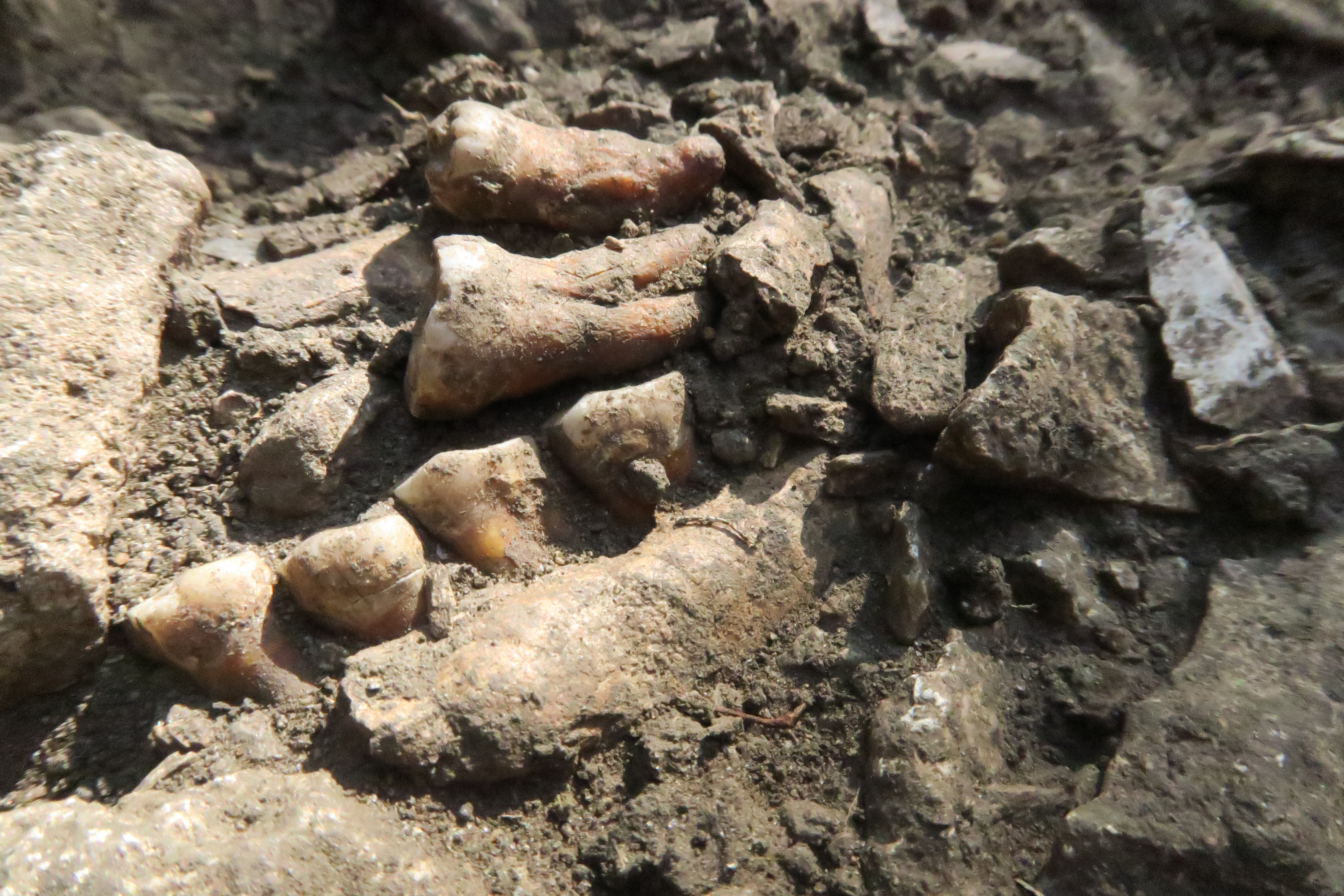Fossils
Fossils Reveal the Face of an Extinct Nine-Foot-Long 'Millipede,' the Largest Arthropod to Ever Live
Scientists in France solved the evolutionary mystery of this prehistoric monster, which resembles both the centipedes and millipedes of today
Admire the World's Largest Collection of Fossilized Poop at the New 'Poozeum' in Arizona
Owner George Frandsen has some 8,000 coprolites from dinosaurs, sharks and other creatures
Divers in Mexico's Underwater Caves Get a Glimpse of Rarely Seen Artifacts, Fossils and Human Remains
Cenotes in the Yucatán Peninsula are time capsules preserving remnants of Maya culture and fossils of extinct megafauna
Rare Jaw Fossils Discovered in Texas Shed Light on a 20-Foot-Long Mosasaur
Unearthed last year, the remains could reveal new information on the extinct sea reptile, which crushed mollusks and shelled creatures with its large, round teeth
Remarkable 200-Year-Old Rock Painting May Depict a Strange Animal That Went Extinct 250 Million Years Ago
The Horned Serpent Panel from southern Africa predates the first Western scientific description of the dicynodont, a large mammal ancestor with tusks, by at least a decade
Dinosaurs Evolved Feathers for Far More Than Flight
Fluff and fuzz helped the creatures keep warm, blend in and communicate
In a Landmark Study, Scientists Discover Just How Much Earth's Temperature Has Changed Over Nearly 500 Million Years
Researchers show the average surface temperature on our planet has shifted between 51.8 to 96.8 degrees Fahrenheit
Construction Project Unearths Millions of Fossils Beneath a Los Angeles High School
The discoveries include sharks, shorebirds, mammals and saber-toothed salmon, with the oldest remains dating to almost nine million years ago
Four Places to Find Fossilized Shark Teeth in the United States
Sharks have been losing teeth for 400 million years. Here’s a guide to uncovering some of these plentiful fossils across the country
Ancient DNA Reveals Neanderthal Group Was Isolated for 50,000 Years
A new study, based on the remains of a Neanderthal nicknamed Thorin, is shaking up what archaeologists long thought about these early humans in Europe
Why Did Dinosaurs Have Horns? It May Not Have Been Simply for Defense
Triceratops and its relatives may have evolved the structures for fighting, impressing mates, and more
Miners Unearth a Mummified Woolly Rhino in Siberia, With an Intact Horn and Soft Tissue
The rare discovery will help scientists find out more about the prehistoric animal’s development, diet and living conditions
'Matching' Dinosaur Footprints Discovered in Africa and South America
The fossils show how dinosaurs may have crossed between landmasses around 120 million years ago, when the continents were still connected
20,000-Year-Old Columbian Mammoth Bones Discovered in Texas
While fishing at an undisclosed lake, Sabrina Solomon slipped and fell—and came face to face with the remains
‘Fearsome’ Saber-Toothed Cats Needed Their Baby Teeth and Mommies, Too
According to new research, two sets of sabers and unusual lower jaw anatomy show that the saber-toothed cat Smilodon fatalis delayed adulting with a long weaning period
Rare Fossils Give Clues to How Tardigrades Survived Mass Extinctions by Hitting the Snooze Button
Scientists have only four known tardigrade fossils, which preserve insights into how the hardy critters evolved their hibernation-like superpower of cryptobiosis
Rare Seven-Foot Mammoth Tusk Unearthed in Mississippi Creek
The enormous fossil belonged to a Columbian mammoth, a larger relative of the woolly mammoth
Fossils Shed New Light on Small 'Hobbit-Like' Humans That Lived on a Remote Island
Two teeth and a small adult arm bone found in Indonesia suggest the ancestors of Homo floresiensis were even shorter than scientists previously thought
This Innovative Device Allows South American Paleontologists to Share Fossils With the World
PaleoScan offers scientists at far-flung institutions a less expensive way to digitize their collections and preserve at-risk specimens of fish, turtles, pterosaurs and more
The Largest T. Rex Could Have Been 70 Percent Heavier Than Fossils Suggest
Two scientists used modeling to predict how big the giant carnivores could have really grown, making a point that fossils likely don't represent the largest or smallest individuals of a species
Page 1 of 53
:focal(2554x1727:2555x1728)/https://tf-cmsv2-smithsonianmag-media.s3.amazonaws.com/filer_public/4c/a5/4ca505c3-da42-4a94-8c1b-5c030840300c/gettyimages-89173104.jpg)
:focal(1800x1800:1801x1801)/https://tf-cmsv2-smithsonianmag-media.s3.amazonaws.com/filer_public/d2/45/d245500b-55ff-4c77-bc45-5aa549ccc5ef/the_poozeum.jpg)
:focal(1000x662:1001x663)/https://tf-cmsv2-smithsonianmag-media.s3.amazonaws.com/filer_public/59/44/5944fdd6-8215-4a86-854f-782ec0b2e58e/martin_broen_page22.jpg)
:focal(425x320:426x321)/https://tf-cmsv2-smithsonianmag-media.s3.amazonaws.com/filer_public/21/4f/214fb752-d077-486e-a6b2-dca284c50163/globidens-alabamaensis.jpeg)
:focal(665x554:666x555)/https://tf-cmsv2-smithsonianmag-media.s3.amazonaws.com/filer_public/05/6d/056dc6d3-47ac-4431-9927-e6bb050cb20e/press_1.jpg)
:focal(800x602:801x603)/https://tf-cmsv2-smithsonianmag-media.s3.amazonaws.com/filer_public/37/d0/37d09203-b627-4452-baf1-b8ed3443962f/main_featherdinos-v2_web.jpg)
:focal(800x602:801x603)/https://tf-cmsv2-smithsonianmag-media.s3.amazonaws.com/filer_public/ec/b5/ecb51952-8e64-4a94-bdf5-377989665a5f/2-nmnh-2018-01015_web.jpg)
:focal(212x222:213x223)/https://tf-cmsv2-smithsonianmag-media.s3.amazonaws.com/filer_public/9a/b6/9ab6feb8-e0ff-4913-938b-3f34ef629257/wayne.jpg)
:focal(1790x1279:1791x1280)/https://tf-cmsv2-smithsonianmag-media.s3.amazonaws.com/filer_public/a1/5f/a15f9d32-b1a9-44fa-88b8-1f6e96f2e1f8/gettyimages-128104969.jpg)

:focal(800x602:801x603)/https://tf-cmsv2-smithsonianmag-media.s3.amazonaws.com/filer_public/18/b6/18b6d2a8-c3ad-4d9a-bcc2-2f933f6f7298/image2_lokiceratops-scene_fabrizio-lavezzi_web.jpg)
:focal(500x333:501x334)/https://tf-cmsv2-smithsonianmag-media.s3.amazonaws.com/filer_public/d6/19/d6199f35-763b-47e4-a469-43488f0b271f/horn.jpeg)
:focal(2304x1733:2305x1734)/https://tf-cmsv2-smithsonianmag-media.s3.amazonaws.com/filer_public/b2/6c/b26c25c1-b703-4c9f-960d-06d78eba8581/passagem_das_pedras_1.jpg)
:focal(2550x1676:2551x1677)/https://tf-cmsv2-smithsonianmag-media.s3.amazonaws.com/filer_public/b1/91/b1911093-3194-4c0d-81cb-a5b0a8a87ccf/gettyimages-1751778506.jpg)
:focal(2289x1482:2290x1483)/https://tf-cmsv2-smithsonianmag-media.s3.amazonaws.com/filer_public/46/f9/46f9d007-90c0-458a-a48b-d670a979d6c6/gettyimages-1041335158.jpg)
:focal(1331x701:1332x702)/https://tf-cmsv2-smithsonianmag-media.s3.amazonaws.com/filer_public/84/ea/84eaccf4-aa95-4c71-83fa-e165dc095671/screenshot_2024-08-19_at_23348_pm.png)
:focal(585x435:586x436)/https://tf-cmsv2-smithsonianmag-media.s3.amazonaws.com/filer_public/56/1a/561a4a0a-368a-40f6-ad69-7294b87944d1/454760755_881979447298948_7913533338667649915_n.jpg)
:focal(750x500:751x501)/https://tf-cmsv2-smithsonianmag-media.s3.amazonaws.com/filer_public/06/08/06083a62-fc31-46a0-a2c1-981fa9ade827/untitled_design_15.png)
:focal(800x602:801x603)/https://tf-cmsv2-smithsonianmag-media.s3.amazonaws.com/filer_public/dd/44/dd446471-a70e-477d-858a-d573b3fbaee9/dsc08418_web.jpg)
:focal(3352x745:3353x746)/https://tf-cmsv2-smithsonianmag-media.s3.amazonaws.com/filer_public/e2/26/e2264891-48be-4dee-b8b6-6cee0f278c86/scotty_tyrannosaurus.jpg)